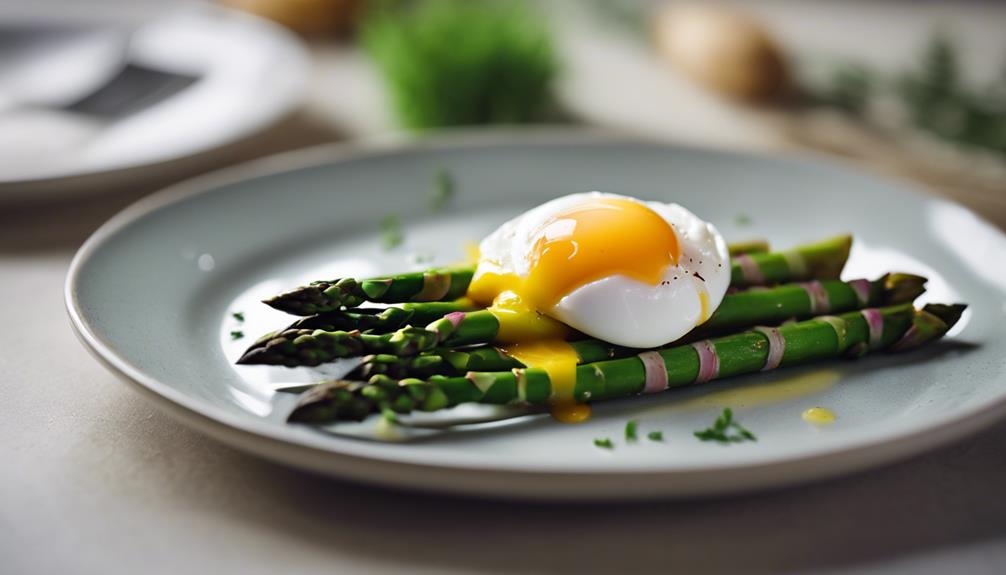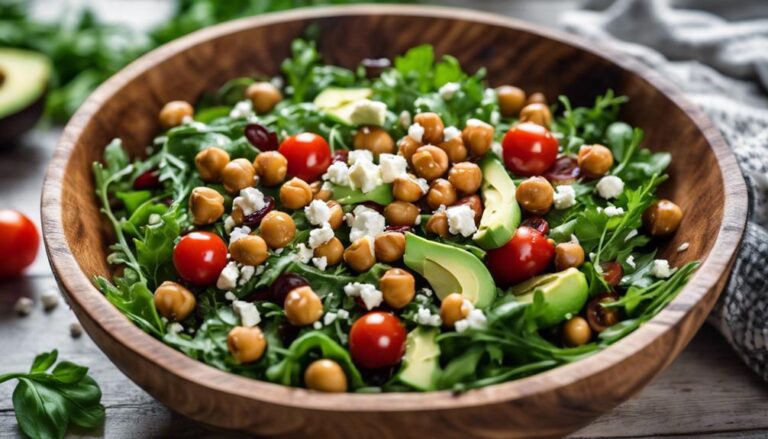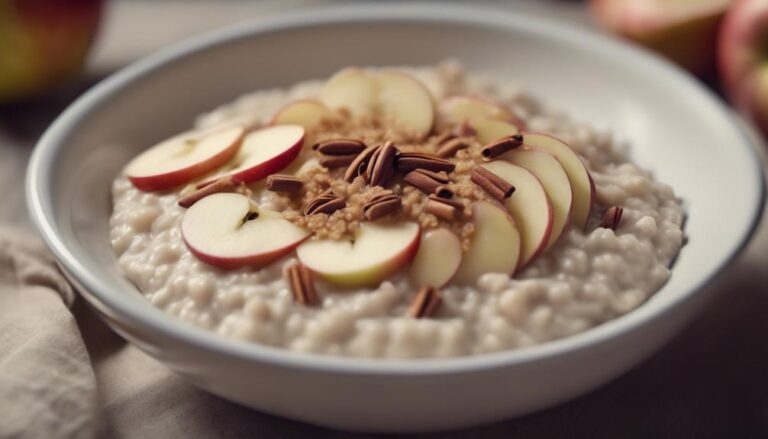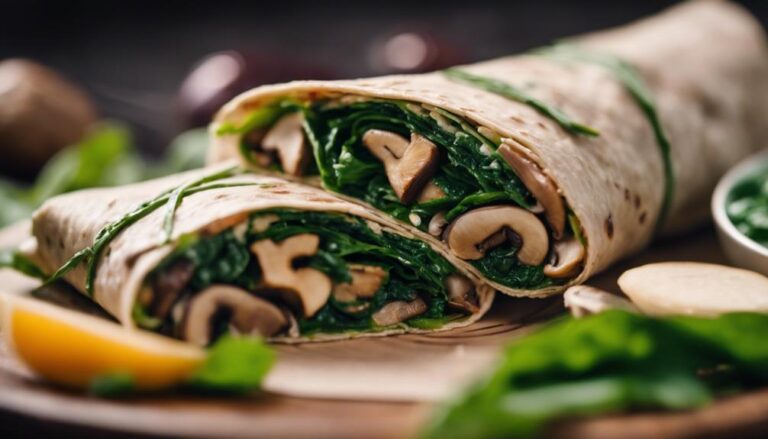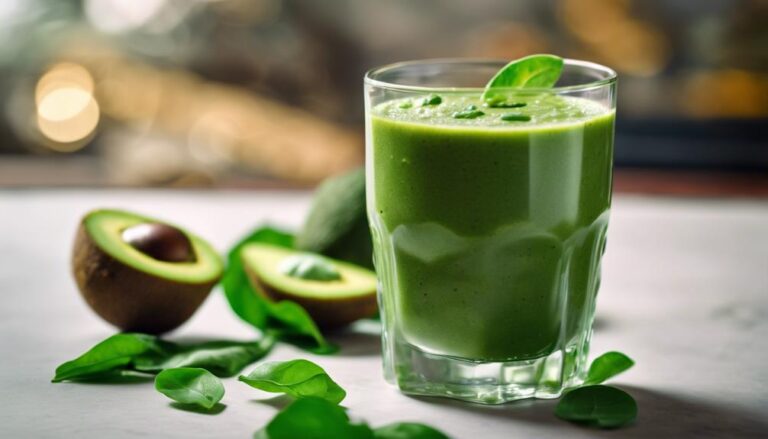Sous Vide Asparagus and Poached Egg
Savor the blend of flavors in sous vide asparagus, tender and vibrant, paired with a poached egg. Achieve peak tenderness and color by blanching your asparagus before the sous vide process. The quick blanching in boiling water and an ice water bath preserves its crispness and vibrant green hue. This technique guarantees your asparagus remains fresh and crunchy, enhancing the overall dish. By mastering this blanching method, you'll elevate the quality of your sous vide asparagus and poached egg combo. Perfect your culinary skills with this harmonious pairing.
What You Will Learn Here
- Blanch asparagus before sous vide for color preservation and texture.
- Rapid blanching ensures vibrant green hue and flavor retention.
- Ice water bath after blanching maintains crispness and nutrients.
- Season boiling water with salt for flavorful blanching process.
- Sous vide cooking enhances precision and flavor absorption in asparagus.
Asparagus Cultivation Origins
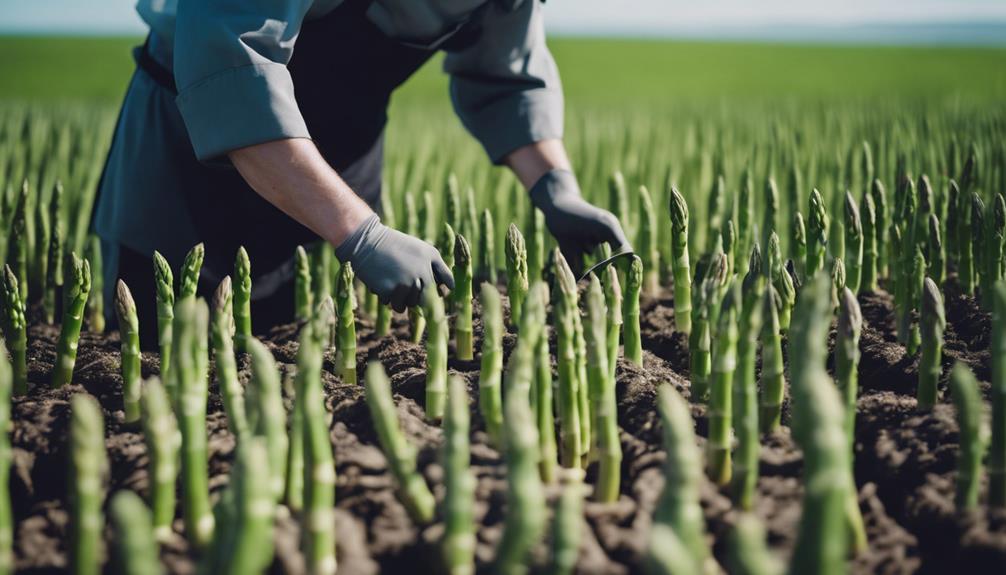
Asparagus, a vegetable known for its unique taste and nutritional value, has a long history that traces back to ancient civilizations.
The cultivation of asparagus can be linked to various regions worldwide, showcasing the diverse ways in which this vegetable has been grown and consumed.
Understanding the evolution of asparagus cultivation sheds light on how this plant has been valued and utilized throughout different periods of history.
Asparagus Historical Cultivation
During ancient times, the cultivation of asparagus dates back to early Mediterranean civilizations. Asparagus holds significant historical significance due to its presence in the diets of ancient Egyptians, Greeks, and Romans. These civilizations not only valued asparagus for its culinary uses but also for its medicinal properties, believing it could treat ailments ranging from toothaches to bee stings. The cultivation of asparagus had a profound cultural impact, symbolizing luxury and sophistication. It was often reserved for the tables of the wealthy and elite, becoming a status symbol in various societies.
The history of asparagus cultivation reveals how this vegetable transcended mere sustenance to become a symbol of wealth and refinement. Its journey from ancient Mediterranean civilizations to modern-day cuisine showcases how certain foods can carry a rich cultural legacy. As you savor a dish of sous vide asparagus and poached egg, remember that you're partaking in a tradition that has been cherished for centuries.
Ancient Origins of Asparagus
The origins of cultivating asparagus trace back to ancient civilizations around the Mediterranean region. Asparagus, with its delicate flavor and unique texture, held a special place in the cultures of these ancient societies. It wasn't just a vegetable but also carried symbolic meanings and was involved in various rituals.
In many ancient civilizations, asparagus was considered a symbol of prosperity and abundance. Its tall spears breaking through the ground symbolized the arrival of spring and the renewal of life. Asparagus was often included in feasts and ceremonies to bring good fortune and blessings to the community.
Furthermore, rituals involving asparagus were common in religious practices and celebrations. The Greeks and Romans, for example, believed in the vegetable's cleansing properties and used it in purification rituals. Asparagus was also associated with fertility and love in some cultures, where it was included in marriage ceremonies and fertility rites.
The ancient origins of asparagus cultivation reveal a deep connection between this vegetable and human societies, showcasing how food can carry symbolic significance and play a role in cultural practices.
Asparagus Cultivation Evolution
Originating in ancient civilizations, the evolution of asparagus cultivation holds a rich history of agricultural practices and cultural significance. Over time, asparagus farming has adapted to embrace modern techniques, leading to more efficient and sustainable farming practices. These advancements have improved crop yields while minimizing environmental impact.
One of the key aspects of the evolution of asparagus cultivation is the recognition of its nutritional benefits. Asparagus is a rich source of vitamins and minerals, making it a valuable addition to a balanced diet. Farmers have capitalized on these health advantages, promoting asparagus as a nutritious vegetable with year-round appeal.
Furthermore, the seasonal availability of asparagus has played an important role in its cultivation evolution. By understanding and respecting the natural growing cycles of asparagus, farmers have been able to optimize production and secure a consistent supply for consumers. This harmonious balance between nature's rhythms and agricultural practices is vital for the sustainability of asparagus farming in the modern world.
Asparagus Pairings
For the best dining experience, consider pairing asparagus with complementary flavors such as lemon, Parmesan, or prosciutto. Asparagus, with its unique earthy taste, can be enhanced by combining it with ingredients that complement its natural flavors.
Here are some delicious pairings to elevate your asparagus dishes:
- Lemon: The invigorating acidity of lemon adds a revitalizing zing to the grassy notes of asparagus.
- Parmesan: The nuttiness of Parmesan cheese creates a rich and savory contrast to the mild sweetness of asparagus.
- Prosciutto: The saltiness of prosciutto pairs perfectly with the delicate taste of asparagus, creating a harmonious blend of flavors.
- Hollandaise sauce: The creamy and buttery texture of Hollandaise sauce drizzled over asparagus enhances its richness, making it a classic and decadent pairing.
These flavorful pairings and creative recipes utilizing seasonal ingredients capture current culinary trends, offering a delightful dining experience that celebrates the versatility of asparagus.
Trending Asparagus Dishes
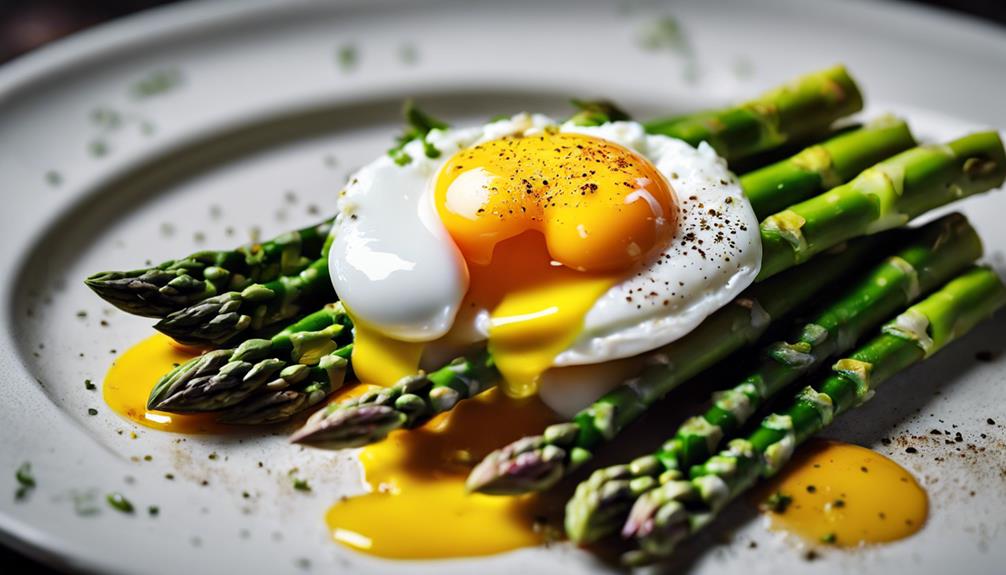
If you're curious about the latest trends in asparagus dishes, consider trying out these popular options:
- The Sous Vide Asparagus Recipe for a modern twist.
- The Egg Benedict Variation for a classic brunch favorite.
- The Asparagus Stuffed With Crab for a luxurious seafood-inspired dish.
These recipes showcase the versatility of asparagus and how it can be incorporated into various culinary creations. Experimenting with these trending dishes can add a fresh and exciting touch to your cooking repertoire.
Sous Vide Asparagus Recipe
Indulge in the latest culinary trend by mastering the art of preparing Sous Vide Asparagus, a delectable dish that's taking the food scene by storm. Using the sous vide technique guarantees that the asparagus retains its vibrant color, crisp texture, and ideal flavor, making it a standout side dish or even a main course.
Here's how to create this mouthwatering dish:
- Prepare the Asparagus: Trim the woody ends of the asparagus spears and season them with olive oil, salt, and pepper.
- Vacuum Seal: Place the seasoned asparagus in a vacuum-sealed bag, ensuring they're in a single layer to cook evenly.
- Sous Vide Cooking: Submerge the sealed bag in a water bath set to 185°F (85°C) and cook for 30 minutes to achieve the perfect tenderness while preserving the asparagus's nutrients.
- Serve and Enjoy: Once cooked, remove the asparagus from the bag, plate it elegantly, and pair it with poached eggs for a delightful and nutritious meal that will impress your taste buds.
Egg Benedict Variation
To explore a trendy twist on classic Eggs Benedict, consider incorporating sous vide asparagus for a flavorful variation that elevates this beloved dish.
When preparing this Egg Benedict variation, keep in mind some key points for a delicious outcome:
- Poached Egg Techniques: Master the art of poaching eggs to perfection for that runny yolk goodness that complements the asparagus beautifully.
- Sous Vide Asparagus: Utilize sous vide cooking for the asparagus to guarantee a tender texture and intense flavor that traditional boiled asparagus can't match.
- Hollandaise Sauce: Don't forget the classic hollandaise sauce to tie all the elements together with its rich, buttery goodness.
- Breakfast Variations: Experiment with different toppings like crispy bacon, smoked salmon, or even a sprinkle of truffle oil to add your own unique twist to this Egg Benedict variation.
Asparagus Stuffed With Crab
For a delectable twist on asparagus, consider trying out the trending dish of Asparagus Stuffed With Crab. This innovative recipe combines the freshness of asparagus with the rich flavors of crab stuffing, creating a dish that's sure to impress your taste buds.
Here are some key points to keep in mind when preparing this delectable dish:
- Crab stuffing: The succulent crab meat mixed with breadcrumbs, herbs, and spices creates a flavorful and luxurious stuffing for the tender asparagus spears.
- Flavor combinations: The sweetness of the crab meat pairs perfectly with the earthy taste of asparagus, while hints of lemon zest and garlic add depth to the overall flavor profile.
- Baking perfection: Make sure to bake the asparagus until the spears are tender and the crab stuffing is golden brown and crispy on top.
- Presentation: Serve the stuffed asparagus as an elegant appetizer or a sophisticated side dish at your next dinner party to wow your guests with this gourmet creation.
Asparagus Blanching Technique
When blanching asparagus, the quick method involves boiling water, submerging the asparagus briefly, then transferring it to ice water to stop the cooking process. This technique helps to retain the vibrant green color and guarantees the asparagus remains perfectly tender.
Quick Blanching Method
Enhance the vibrant green color and tender texture of your asparagus by quickly blanching it in boiling water before finishing it with a poached egg in this delightful sous vide recipe. The quick blanching method involves briefly immersing the asparagus in boiling water for about 1-2 minutes. This step helps to secure the bright green color of the asparagus while slightly softening its texture for a perfect sous vide finish.
To quick blanch your asparagus, bring a pot of water to a rolling boil and add a pinch of salt. Carefully place the asparagus spears into the boiling water and let them cook for just a couple of minutes. Once they turn a vibrant green color and become slightly tender, immediately transfer them to an ice water bath to halt the cooking process.
This rapid blanching not only enhances the visual appeal of your dish but also guarantees that the asparagus retains its crispness and flavor when cooked sous vide. Mastering this quick blanching technique will elevate the overall quality of your sous vide asparagus and poached egg dish.
Retaining Vibrant Green
To ensure the vibrant green color of your asparagus is preserved, employ a blanching technique that involves a brief immersion in boiling water before sous vide cooking. This step is essential for color preservation and is a common practice in cooking techniques to lock in the asparagus's natural vibrancy. By blanching the asparagus briefly, you halt the enzymes that cause discoloration, ensuring your asparagus retains its appealing green hue throughout the cooking process.
Blanching not only helps with color preservation but also plays a role in texture retention when using sous vide methods. The quick plunge into boiling water softens the outer layer of the asparagus, making it more receptive to the sous vide cooking process. This technique aids in maintaining the crunch and freshness of the asparagus while allowing it to absorb the flavors from the sous vide cooking environment.
Perfectly Tender Asparagus
For achieving perfectly tender asparagus, consider employing a blanching technique before sous vide cooking to enhance both texture and flavor retention. Blanching involves briefly immersing the asparagus in boiling water, followed by immediate cooling in ice water. This method helps to soften the fibrous exterior while preserving the vibrant green color and locking in the vegetable's natural flavors.
To begin, bring a pot of water to a boil and add a generous amount of salt for flavorful seasoning. Submerge the asparagus spears in the boiling water for about 1-2 minutes, depending on the thickness of the stalks. The goal is to slightly cook the asparagus without making it mushy.
After blanching, quickly transfer the asparagus to a bowl of ice water to halt the cooking process. This rapid cooling step guarantees that the asparagus retains its crispness and nutrients. Once cooled, pat the asparagus dry before proceeding with the sous vide cooking techniques for a perfectly tender and delicious result.
Final Thoughts
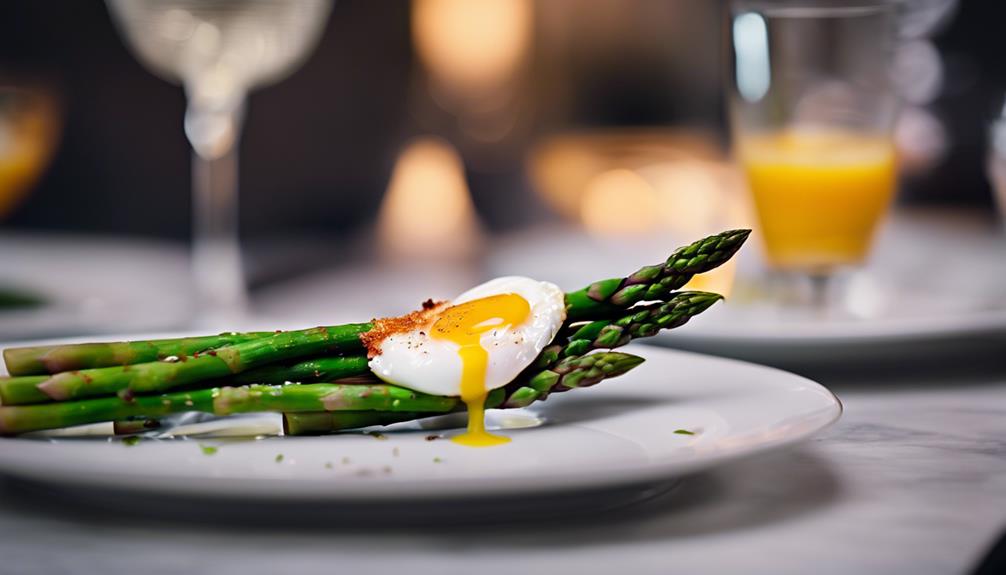
Consider reflecting on your experience with this delightful dish and how you can personalize it to suit your tastes and preferences. As you think back on your culinary journey with this sous vide asparagus and poached egg recipe, take a moment to ponder the reflections it has brought about. Perhaps you discovered a newfound appreciation for the precision of sous vide cooking or the delicate art of poaching an egg. These culinary techniques can serve as a foundation for your future kitchen experiments.
In your final thoughts, remember that cooking isn't just about following a recipe to the letter but about infusing your personality and creativity into each dish. Feel free to adjust the seasoning, try different garnishes, or even explore alternative cooking methods to make this recipe truly your own. Whether you prefer a runny yolk or a firmer texture on your asparagus, don't be afraid to tailor the recipe to your liking. Embrace the opportunity to experiment and make this dish a reflection of your unique culinary style.
Frequently Asked Questions
Can I Use Frozen Asparagus for Sous Vide Cooking?
Yes, you can use frozen asparagus for sous vide cooking. It's convenient and still yields tasty results. Remember to adjust cooking times slightly for frozen veggies. Check for doneness before finishing with your favorite sous vide tips for a perfect poached egg.
How Can I Prevent the Poached Egg From Breaking?
To prevent the poached egg from breaking, make sure to use fresh eggs and simmer, not boil, the water. Gently swirl the water to create a vortex before dropping the egg in for a better shape and presentation.
Is It Necessary to Peel Asparagus Before Cooking Sous Vide?
When cooking sous vide, peeling asparagus isn't necessary. Keeping the peel on can enhance flavor retention and texture control. Plus, it saves time and adds to the convenience factor. Enjoy the asparagus with its peel for a delightful culinary experience.
What Other Proteins Can Be Paired With Asparagus?
When pairing asparagus, consider grilled salmon for a flavorful combination or roasted chicken for a classic option. These proteins complement the earthy tones of asparagus, creating a delightful culinary experience that satisfies a range of tastes.
Can I Reuse the Sous Vide Cooking Water for Other Dishes?
You can reuse sous vide cooking water for other dishes, promoting water conservation and sustainability. The liquid retains flavor from previous cooking, providing a base for future recipes. Guarantee proper storage and reheating to maintain food safety.
Conclusion
To sum up, sous vide asparagus and poached egg make for a delicious and elegant dish that highlights the natural flavors of each ingredient.
The sous vide cooking method guarantees that the asparagus is perfectly cooked, while the poached egg adds a creamy and luxurious touch.
This dish is versatile and can be enjoyed for breakfast, brunch, or a light dinner.
Give it a try and impress your friends and family with this gourmet creation.
